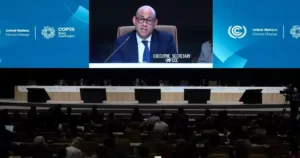The dense fog in Delhi-NCR on Friday has brought life to a standstill. The India Meteorological Department (IMD) has issued an Orange Alert, indicating severe weather conditions in the region. The thick fog has drastically reduced visibility, affecting traffic and daily activities on a large scale.
Fog Conditions and Impact
Visibility in Delhi-NCR dropped to less than 50 meters during the morning hours. The fog is so dense that drivers are relying heavily on headlights and fog lights. This has slowed traffic on the roads and increased the risk of accidents. Rail and air traffic have also been disrupted, with many trains running late and several flights either canceled or rescheduled.
What Does Orange Alert Mean?
An Orange Alert signifies serious conditions, and citizens are advised to remain cautious. Under this alert, people are recommended to avoid non-essential travel and limit outdoor activities. Special precautions are advised for the elderly, children, and those with pre-existing health conditions.
Causes of the Fog
The dense fog conditions are primarily due to the following factors:
- Drop in Minimum Temperature: The minimum temperature in Delhi-NCR has fallen below 5 degrees Celsius. Cold winds and high humidity have accelerated the formation of fog.
- Impact of Pollution: Air pollution in the region also contributes to the density of fog. Particulate matter like PM 2.5 and PM 10 combine with moisture in the atmosphere, increasing the thickness of the fog.
- Geographical Factors: The geographical location of Delhi-NCR exacerbates the problem. The areas around the Yamuna River have higher moisture levels, aiding in fog formation.
Impact on Daily Life
- Effect on Traffic:
- Vehicles are moving at a slow pace, leading to traffic jams.
- Visibility on highways and expressways is extremely low, increasing the risk of accidents.
- Public transport services are also delayed.
- Rail and Air Traffic:
- Several trains are delayed by hours, causing inconvenience to passengers.
- Flight operations at airports are facing delays and cancellations.
- Health Impacts:
- The cold and pollution have heightened the risk of respiratory issues and other health complications.
- Patients with asthma and bronchitis are particularly vulnerable and need to exercise extra caution.
Government and Administrative Preparations
Authorities in Delhi and surrounding areas have taken several measures:
- Traffic Management:
- Traffic police have issued guidelines to control vehicle speed during foggy conditions.
- Deployment of traffic personnel in sensitive areas has been increased.
- Public Awareness:
- Citizens are being informed about the risks and precautions through radio and social media.
- Healthcare Services:
- Emergency services in hospitals are on high alert.
- Health camps are being set up to address fog-induced health issues.
Safety Measures
To stay safe during dense fog, the following precautions can be taken:
- Caution While Driving:
- Use headlights and fog lights while driving.
- Maintain slow speeds and keep a safe distance from other vehicles.
- Avoid overtaking.
- Limit Outdoor Activities:
- Wear masks and warm clothing to protect against cold air.
- Avoid stepping out early in the morning if possible.
- Focus on Health:
- Elderly and children are advised to stay indoors.
- Use air purifiers indoors to combat pollution.
Scientific Perspective on the Fog Problem
The issue of dense fog is becoming more severe due to climate change and rising pollution levels.
- Atmospheric Changes:
- Climate change has intensified cold winds and high humidity during winter months.
- Role of Pollution:
- Emissions from industries and vehicles contribute to denser fog.
- Need for Solutions:
- Controlling pollution, promoting greenery, and adopting alternative energy sources can help mitigate this problem.
Conclusion
The problem of dense fog in Delhi-NCR is not just weather-related but is also exacerbated by pollution and climate change. The Orange Alert is a warning for citizens and authorities to remain vigilant and prepared.
Collective efforts and awareness are essential not only to face this situation but also to prevent it in the future. Reducing pollution through sustainable practices and collective action is the long-term solution to this growing problem.






